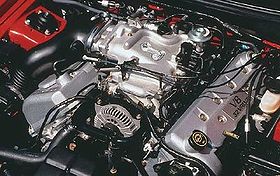Ford Modular engine
| Ford Modular engine | |
|---|---|

A 1999 Ford Mustang SVT Cobra engine.
|
|
| Overview | |
| Manufacturer | Ford Motor Company |
| Also called | Ford Triton Lincoln InTech |
| Production | 1991–present |
| Combustion chamber | |
| Displacement | 281 CID (4601 cc) V8 302 CID (4951 cc) V8 323 CID (5284 cc) V8 330 CID (5408 cc) V8 351 CID (5753 cc) V8 354 CID (5808 cc) V8 415 CID (6802 cc) V10 |
| Cylinder bore | 3.552 in (90.2 mm) 3.629 in (92.2 mm) 3.68 in (93.5 mm) 3.700 in (94 mm) |
| Piston stroke | 3.543 in (90 mm) 3.649 in (92.7 mm) 3.750 in (95.3 mm) 4.165 in (105.8 mm) |
| Valvetrain | OHC with Roller Finger Followers |
| Chronology | |
| Predecessor |
Ford Windsor V8 Ford 385 V8 |
The Ford Modular engine is Ford Motor Company's overhead camshaft (OHC) V8 and V10 gasoline-powered engine family. The Modular engine got its name from its design and sharing of certain parts among the engine family, starting with the 4.6L in 1991. The name was also derived from a manufacturing plant protocol, "Modular", where the plant and its tooling could be changed in a few hours to manufacture different versions of the engine family. The Modular engines are used in various Ford, Lincoln, and Mercury vehicles. Modular engines used in Ford trucks were marketed under the Triton name from 1997–2010 while the InTech name was used for a time at Lincoln for vehicles equipped with DOHC versions of the engines. The engines were first produced in Romeo, Michigan then additional capacity was added in Windsor, Ontario.
In the early 1980s, the chief operating officer Donald Petersen challenged Ford’s vice-president of design, Jack Telnack, and his staff to come up with new vehicle designs that they could take pride in. The result was sleeker, more aerodynamic designs like that used for the highly successful Ford Taurus. In the second-half of the 1980s Peterson undertook to update Ford’s decades-old V8 architectures, challenging Ford senior engineer Jim Clarke to do for Ford’s V8s what Jack Telnack did for Ford’s vehicle design. The objective was to develop a completely new V8 engine that would surpass Ford’s earlier V8s in every meaningful way, from power and efficiency to emissions performance and smoothness of operation.
Clarke and his engineers studied engine designs from major European and Japanese automakers and sought to create a modern V8 engine that would be power-dense while still surviving up to 100,000 miles of use. The initial engine design would implement a 90° vee-angle with a bore of 90.2 mm (3.552 in) and a stroke of 90 mm (3.543 in), resulting in a 4.6-liter (4601 cc, 281 CID) displacement and creating a nearly 1:1 bore-to-stroke ratio. This square configuration was chosen primarily for its positive noise, vibration and harshness characteristics. The engine would utilize features such as a chain-driven, single-overhead camshaft valvetrain with roller finger followers, a deep-skirt cast-iron block construction and cross-bolted main bearings, all benefitting long-term durability. In the interest of reducing overall engine weight, aluminum-alloy heads and pistons would be standard and all major engine accessories would be mounted directly to the block, resulting in more complex block casting but eliminating the need for heavy mounting brackets. Tight construction tolerances were used in shaping the engine’s cylinder bores with narrow piston rings fitted to the engine’s pistons. This would serve to improve engine efficiency through reduced friction and reduce the engine’s oil consumption, while also promoting cleaner emissions.
...
Wikipedia
